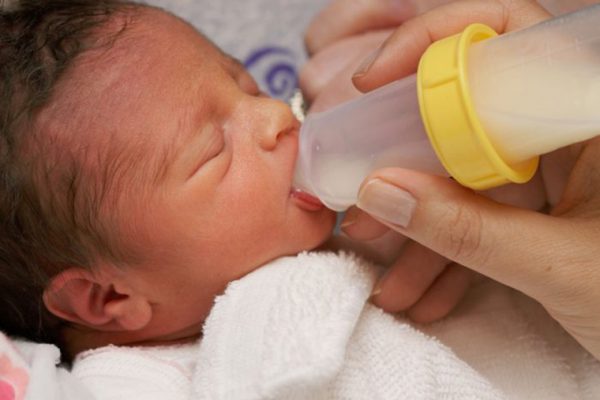Infant formula is designed to mimic human breast milk not only in nutrients but also by nurturing a similar set of microbes in the digestive tract. Such microbes are indispensable in keeping us healthy: They crowd out disease-causing bacteria, influence our metabolism, and synthesize many vitamins and amino acids, the building blocks of proteins.
Now, a new study finds that while formula and breast milk encourage the growth of similar kinds of bacteria in babies’ digestive tracts, the bacteria work differently. The health implications of these differences are as yet unclear.
“Formula makers are continually tweaking their ingredients, and they’ve been very successful in eliciting the right mix of bacteria,” said senior author Gautam Dantas, professor of pathology and immunology, of biomedical engineering and of molecular microbiology at Washington University School of Medicine in St. Louis. “But almost all the studies to date have looked at the identity of the bacteria, not what they’re doing. What we found here is that the bacteria might look the same, but they’re not doing the same thing.”
The findings are published Oct. 29 in Nature Medicine.
Dantas, first author Aimee M. Baumann-Dudenhoeffer, MD, an assistant professor of pediatrics, and colleagues analyzed the complete DNA of bacteria from 60 babies to identify the members of each child’s gut microbiome – the community of bacteria that live in the digestive tract. They also determined which amino acids and other biomolecules the gut bacteria were capable of synthesizing and breaking down. Gut microbes release metabolic byproducts that influence physiologic functions including nutrition, inflammation and digestive health.
The researchers analyzed fecal samples previously collected from 2009 to 2011 through the St. Louis Neonatal Gut Microbiome Project led by Barbara B. Warner, MD, a professor of pediatrics, and Phillip I. Tarr, MD, the Melvin E. Carnahan Professor of Pediatrics. The researchers studied 402 fecal samples collected monthly from birth to age 8 months from 30 sets of twins born in the St. Louis area. They also collected information on how the babies were fed, including the specific brands of infant formula purchased.
Breast milk is rich in protein in the first days after birth, but then protein levels decline. The researchers found that the microbiome of breastfed babies compensated for low levels of certain amino acids by increasing the levels of bacteria equipped with the genetic software to synthesize such amino acids – notably methionine, isoleucine, leucine, valine, cysteine, serine, threonine and arginine.
Formula-fed babies, on the other hand, harbored bacteria capable of making a very different set of amino acids. Their gut bacteria were outfitted to make less methionine and cysteine – amino acids that are more plentiful in formula than in breast milk – and more histidine and tryptophan, which are scarcer in formula than in breast milk.
“The goal of all formulas is to look breast milk-like, and they’re not achieving that,” Dantas said. “In terms of which bacteria are there, they look similar, but in terms of what they have the genetic potential to do, it’s not the same. Different doesn’t mean bad, but different does mean different, and we have to understand what the health consequences are.”
Many formulas now contain sugar molecules designed to imitate human milk sugars, which are added to promote a more breastfed-like microbiome. In particular, these sugars promote the growth of Bifidobacteria, a key part of a healthy microbiome in infants and children. The researchers found that babies consuming formula that included replicas of human milk sugars grew more Bifidobacteria than those on formula without such sugars – a good sign – but their microbiome’s metabolic toolkit still differed from breastfed babies’.
The study included six children who were fed soy formula. The soy-fed infants generated a total of 37 fecal samples, some taken before the babies were switched to soy formula. The soy-fed babies’ microbiomes were strikingly different from the rest of the childrens’, with scant Bifidobacteria but abundant genetic tools for producing short-chain fatty acids. The combination is a sign of an unhealthy microbiome, but the choice of soy formula may have been the result of an unbalanced gut, not the cause of it, the researchers said. Bifidobacteria had been sparse in the soy-fed infants even before they started on the soy formula.
“We don’t know why the parents selected soy formula for these kids, but we do know babies with low Bifidobacteria are more likely to be colicky, and when babies are fussy, parents tend to try new formulas,” Baumann-Dudenhoeffer said. “These kids were unique in terms of being very low in the organism that we know is good for healthy development. So I think this tells us that there is a population of children who might benefit from probiotics or some other intervention to promote Bifidobacteria growth.”
Dantas and Baumann-Dudenhoeffer now are considering ways to determine which children could benefit from fine-tuning their gut microbiome, and how to do it.
“Early infancy is a critical period for neurodevelopment and physiologic development,” Baumann-Dudenhoeffer said. “Many of the synthesis pathways we found to be more abundant in breastfed infants were for vitamins and other developmentally critical nutrients. If we can alter the microbiome, even if the effect is purely temporary, it could still have important positive effects.”



